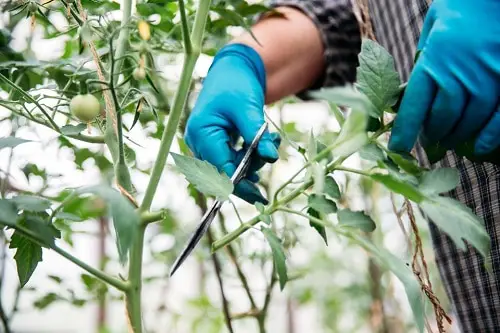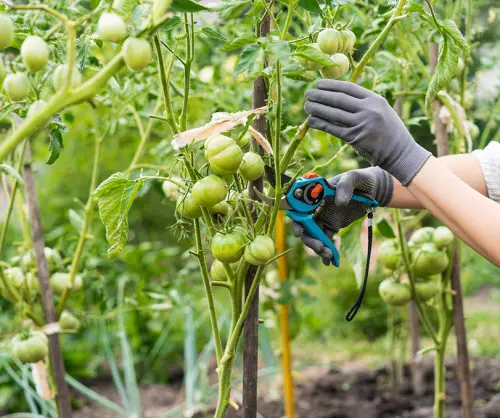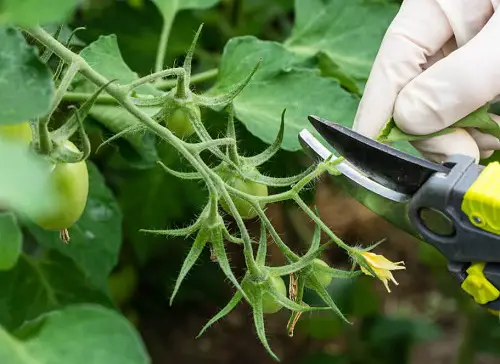Learn all the tips and tricks about Pruning Tomato Plants for Bumper Harvest that also help to keep the plants tidy and disease free!

Pruning Tomato Plants correctly not only boosts productivity but also helps them to stay healthy and disease free while making sure it speeds up the ripening process. Let’s learn everything in detail about Pruning Tomato Plants for Bigger Harvests!
Here’s how you can use coco peat for a bumper tomato harvest
Determine the Type of Tomato Plants First
- Determinate Plants: These plants are usually compact, more suitable for containers, and grow to an appropriate height and flower and fruit for a short amount of time. You don’t need to prune them much if you are growing determinate type.
- Indeterminate Plants: They fruit throughout the season and should be elevated while growing to keep them off the ground. You need to prune them a bit.
Pruning Tomato Plants for Bigger Harvests

1. Pinch the Seedlings (Optional)
Pinching tomato seedlings can improve their growth and productivity. This process involves removing the terminal bud, or the top portion of the plant, which stimulates the plant to grow bushier and produce more fruit-bearing branches.
When a tomato plant’s terminal bud is removed, it redirects the plant’s energy into developing more lateral branches, which can lead to a fuller and more robust plant.
Additionally, pinching can help to control the plant’s size and prevent it from becoming too tall or leggy, making it easier to manage and harvest.
2. Remove Suckers
It is important to remove suckers from tomato plants routinely. Suckers are the small shoots that grow in the axils (the area between a stem and a branch) of the tomato plant.
Removing suckers will help to focus more energy on the production of better quality and larger fruits rather than smaller, less desirable ones. Also, suckers won’t produce flowers or fruits, so it’s best to get rid of them.
To remove suckers, use sharp pruning shears or simply use your fingernails. Cleanly cut the suckers off just above the main stem, being sure to make a neat cut. Dispose of the suckers, and be sure to wash the shears before using them on other plants.
3. Prune After It Flowers
Pruning tomatoes after flowering is a great way to increase the health and productivity of your tomato plants. It should be done when the plants are in the flowering stage and the flowers are starting to form fruit.
During this time, you should remove any tips, leaves, or branches that are shading the fruit, as this can reduce the number of tomatoes that the plant produces. Additionally, you should remove any dead or diseased leaves or stems.
4. Get Rid of Lower Leaves
Trimming the lower leaves of tomato plants, especially when they are young, can be beneficial for the plant and promote healthy growth. In the initial stage, it helps the plant to grow bigger and allows more sunlight to reach the around of the plant, encourages better air circulation, and reduces the risk of fungal diseases.
Additionally, trimming off the lower leaves helps to direct the plant’s energy to the upper leaves and fruits, which can result in larger and more flavorful tomatoes.
Getting rid of the lower leaves of new plants will also allow you to hilling-up the tomato plants when they are a few inches high.
5. Thin Out
Thinning tomato plants involves removing some of the lower, weaker, tangled, and crossing stems and leaves in order to provide the remaining plants with more space, light, and nutrients.
Identify these and snip them off. Be careful to avoid damaging any of the healthy stems and leaves during the process.
After thinning, feed the plants with a rich compost tea or any organic fertilizer and water deeply to allow the roots to absorb the nutrients.
When is the Best Time to Pinch Tomato Plants?
The best time to pinch a tomato seedling is when it has developed its first or second set of true leaves, which typically appear about two to three weeks after germination.
At this stage, the seedling is still young and pliable, and the top growth can be easily removed without causing damage. It’s important to pinch the seedling before it grows too tall and leggy.
Note: If the seedling becomes too tall before pinching, it may be more difficult to manage and may not respond as well to the pinching technique.
‘Topping’ Tomato Plants

Topping tomato plants is a common gardening practice that involves removing the topmost growing point of a tomato plant. This encourages the plant to focus its energy on producing larger, more flavorful tomatoes rather than more stems and leaves.
It will also cause the plant to become bushier, as the side shoots that grow from the topping will be encouraged to produce fruit. To top a plant, simply use a sharp pair of garden scissors to snip off the top of the main stem.
Benefits of Pruning Tomato Plants
1. Improved Air Circulation
Pruning helps open the plant’s canopy and provides better air circulation. This can help to reduce the risk of disease, as well as promote healthier foliage.
2. Increased Sunlight
Sunlight helps to promote healthy growth, and pruning can help to increase the amount of sunlight that reaches the leaves. This helps to improve the plant’s overall health and yield.
3. Improved Yield
It helps to direct the plant’s energy to the most productive parts of the plant, allowing for increased fruit production.
4. Reduced Diseases
Pruning can help to reduce the risk of diseases, as it helps to open up the plant’s canopy and provide better air circulation. This can help to reduce the risk of disease caused by fungal spores or bacteria.
5. Easier Harvesting
This process can also make it easier to harvest the fruits from the plant. By removing excess foliage, you can more easily access the fruits and pick them up without damaging the plant.
Bonus – Missouri Pruning
Missouri pruning is a popular method for managing tomato plants. This pruning technique involves removing the lowest branches and leaves of the plant, leaving three to five main stems. All side shoots or suckers should be removed from the main stems.
Once the suckers have been removed, the leaves should be trimmed to expose the main stems and avoid shading. Finally, the remaining stems should be tied to a stake or trellis for support. This technique encourages air circulation and allows more sunlight to penetrate the fruit, resulting in larger, healthier tomatoes.



As an avid gardener I found the information very useful.